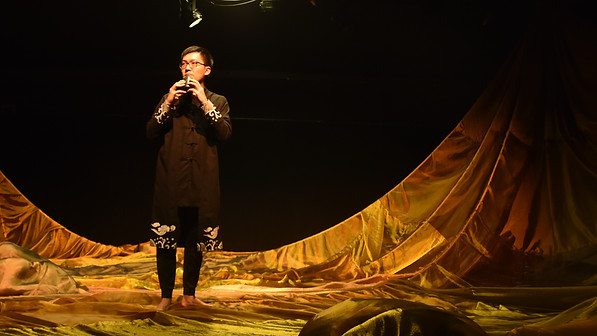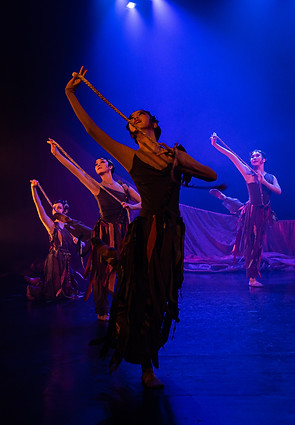top of page

The Susurration of the Tree
A Journal
Content
-
About The Susurration of the Tree
-
Choreography process
-
The Structure
-
Roots
-
Trunk
-
Branches
-
-
Music composition
-
Character
-
-
Experimentation with props
-
Cloth
-
Rope
-
Whip
-
-
Costume and Headpiece

About The Susurration of the Tree
‘The Susurration of the Tree’ explores the relationship between trees and man. Choreographed by Artistic Director Neo Jenny, the piece was inspired by her awe for nature. “How often have we stopped to listen? To their murmurs so wise, so reassuring, so serene, as we hustle-bustle and lose all measures of pace.” As Jenny ponders, she also revisualises that the trail to success comes with will, resilience, and determination.
This new work is a cross-disciplinary collaboration between Jenny and musician Yong Kailin, Dr Tan Qing Lun and Jeffrey Tan. Original music was composed, with improvisation done in reaction to the dancers’ movements, with a wide range of instruments, from dizi, xiao, xun, violin, voices and other axillary instruments, enhanced with music soundscape. Listen closely to the resonating notes as it brings us into nature and the dialogue between the dancers and the musicians.
About The Susurration of the Tree - Inspirations
Mr. Benedict shared with Ms. Jenny the photographs of Angkor Wat- Ta Phohm which is famous for the temples that are overgrown and covered with trees. The roots of the trees attach to the porous sandstone, extracting the water from the stones. The roots are firmly placed on the building itself, slowly crushing it but also holding it up at the same time. She was astonished by the photos and ideas started to run in her brain.


Choreography Process - The Structure - Roots
-
To set the atmosphere, Ms Jenny decided to place a massive curtain of cloth over the stage, to mimic the feeling of being underneath the earth
-
The roots grow little by little, through the soil, inching upwards towards the surface
-
Their movements portray how the roots are very grounded by how they grip the soil and connect to each other


Choreography Process - The Structure - Roots
Choreography Process - The Structure - Trunk


The first part of the plant erupt from the soil, a symbol of growth or new life. It is the first indication that people typically look out for in New plants. As it develops, the trunk slowly gives support, strengthening it from within the plant. This entwining that inspired this section of the piece hopes to show the connection between the dancers.
Choreography Process - The Structure - Trunk
The dancers started to explore and mimic the movements from the photographs they had taken or collected from their research. It started with individual shapes and then Ms. Jenny overlays them to form the shape of the tree trunk.




Choreography Process - The Structure - Trunk
This set of movements appeared 3 times in the dance, Beginning (in the cloth), Scene 2 (above the cloth and towards the end recapitulation (slowly being covered)


Choreography Process - The Structure - Branches
It is the first thing you notice when you see a tree. Unlike their trunk counterparts, they are pliable, ready to bend to the elements as needed, but strong enough to weather through the storm. The adaptability and strength of the branches inspired the use of a whip as our prop in the last section of the piece, to showcase its flexibility.


Choreography Process - Music Composition by House of Music
When I, (Tan Qing Lun) first received the news to collaborate with Jenny on the concept of The Susurration of the Tree, I first have to decide what kind of sound design she had in mind. It would affect my decision of the choice of the instruments and also the depth of immersing in the production. Very quickly, I decided to work with our comfortable yet thought-provoking artist Kai Lin Yong and also soundscape designer Jeffrey Tan. Together with the team, we brainstormed about the sounds and space of the theme and also the outline movement of the production.



Choreography Process - Music Composition by House of Music
The Susurration of the Tree is divided into 5 sections, namely the introduction, scene 1 to 3, and a recapitulation segment. Each of the sections has a distinct element of what Jenny wishes to covey, and we work closely with her concept yet challenge and explored the sound of what we may imagine. KaiLin is someone who has a vase experience and connection with nature, and immediately with his senses, we recorded the start with the choice of voice, which is the most natural and organic sound that would immediately resonate with. I chose xun (埙) as it is one of the oldest instruments in human civilisation and it produces a soulful sound. Together with Jeffery's soundscape, we three came up with a harmonious yet interactive movement toward scene. With the introduction of Jenny’s voice as Mother Nature, it wakes up the cells of the living and slowly building up and giving life to the world. You could catch the heartbeat pulse that we intended to spark the motion in the first scene part of the production.
Choreography Process - Music Composition by House of Music
In the 2nd scene, we explored the Hulusi (葫芦丝), a traditional ethnic wind instrument to create growth and bending melodic lines in contrast with Violin pizzicato. A bundle of bamboo flutes was used to mimic the branches weaving movement by the wind, producing hitting sound giving a touch to the sound of the 2 instruments. With the inspiration from the dance movement, we continue to expand and build to a climax where the dancers construct a complex support movement, twirling around Kai Lin while he performed on the violin in that transition.
After Kai Lin walked out, I came in with the xiao with the extended technique of multiphonics and over-blowing. With the temple gongs settling it after receiving the tension from the previous section and subsequently resolving into a beautiful melodic duet of the xiao and violin. Very quickly, we progress into the last scene where percussion and folk-like tune accompanied by a strong rhythmic motive was introduced. With the violin and dizi dancing in harmony with the dancers, it feasts into the highest point of the music in celebration of life and nature.
Choreography Process - Music Composition by House of Music
Ending off on the high notes, we transform gradually to the recapitulation section with the familiar voice and spaces created from the start, calling out from a return. I walked out with the Xun (埙), played the motif from each of the sections, and walk out to the end of the production.

Choreography Process - Characters

-
Jenny: A tree spirit communicating to the human
-
Dancers: process of growth and development, from the soil all the way to the branches (till they use the whip), signifying the blossoming of their journey


-
Kai Lin: One of the tree masters that plays a supporting role for the dancers on their journey


-
Qing Lun: Human who took a walk in the forest, only to stumble upon Ms Jenny (the tree spirit), and he watches the journey unfold before him personification of looking back on our progress.

Experimentation with props - Cloth
-
Dancers took a while to get used to the material
-
It started with one cloth 9m of length to 210m (final Set)
-
Started with just one layer of cloth, changed to two layers together which create a tunnel-like hollow
-
Sometimes the hole would be too small if you didn’t step on the cloth properly
-
Created a really mysterious effect together with the fog onstage

Experimentation with props - Manilla Rope
.jpg)
-
Dancers played and improvised with it to come up with the movements and settle the desired mood
-
Material of rope was too rough so gloves had to be used to handle it
Experimentation with props - Manilla Rope (On set)
-
Experimented with different anchor points, see which direction created the nice line
-
Set the base for the main set: cloth

Experimentation with props - Whip
-
"Very cool but it was very painful if it hit you, especially the face" - Gabriella
-
Had to paint it appropriate thematic colors, since it only came in white
-
Tried different lengths 1.6m-2m, and found that the longest (2m) worked the best
-
Also affected dancers' movements, because they still had to find a way to safely maneuver with it



Costume
Top
- Asymmetrical designs and cuts
- Dancers liked that it was a unitard, very convenient
Bottom
- Shaped like culottes, but there was a big slit on the side to show the leg line
- Material added a bit of texture
- In hindsight, slit was a good idea, but we had to adjust it to avoid tripping over it since it was easy for our leg to slip thru the slit instead of the leg hole
Skirt
- Very disorienting at first since it got in our faces
- But the aesthetics it brought to the last section was very unique
Hair & makeup
- Used our own hair at first to create the curly “branches”
- But it did not have the desired effect
- So Ms Jenny hired some makeup artists to do less intense opera style of makeup on us
- Tried to mimic those curly branches with the hair



Costume
Process Making - Inspiration and reference

.jpg)
.png)
Headdress process (Gigantic Headdress with 戏曲发片)

.png)


Make-up

Long Dress over 18m long


Reflection
“The dance is out of my comfort zone as I am trained in Chinese folk dance, and this particular piece incorporates contemporary dance. I hope that everyone will be able to see a new side of me in this upcoming production.”
- Wong Zhuo Qin


“I feel the dance is a relatively abstract dance that combines classical and contemporary elements. The biggest challenge would be doing the movements with the whip while still maintaining an elegant composure.”
- Zhang Yin
“The dance reminds me of the process after a heartbreak. You reach deeper into yourself to find the strength to become better to become stronger. We learn to love ourselves again, and we reminisce the sweet beginnings of what was.
The process of building a new piece is always fun. It's like a rediscovery of oneself and also a challenge to cope with the frustration that follows. The frustration of not bringing out what you visualize or the inability to connect with the piece at the start. But as the piece grows, we grow with it, and that process is always fun.'
- Neo Ke Xin

“I find it very exciting to dance to and at the same time, I get to use new props which I haven’t experienced before. I also enjoyed the process of experimentation with the set during rehearsals.”
- Gabriella G.

“It was harder for me, considering it utilises a lot of classical chinese dance technique, and I just started learning chinese dance back in June. I may have struggled with the nuances and style, but I found the dance really cool and unique due to the props and sets."
- Wong Wen Ru

bottom of page
